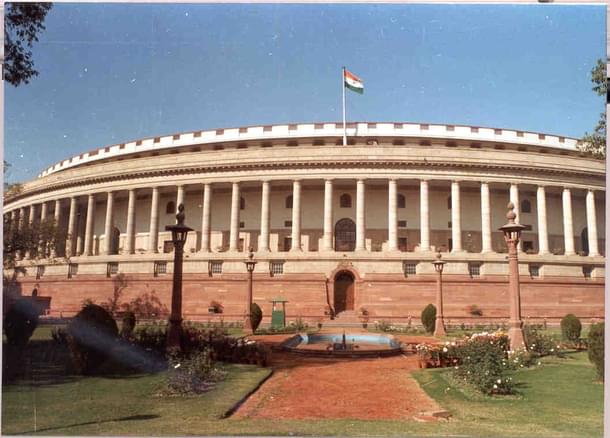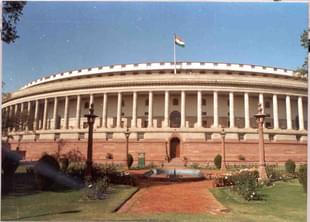Politics
Can Rajya Sabha Be Made Relevant Again?
Narendra Adnoor
Apr 08, 2015, 12:15 PM | Updated Feb 24, 2016, 04:29 PM IST
Save & read from anywhere!
Bookmark stories for easy access on any device or the Swarajya app.


Nominating sycophants, rehabilitating those who should have retired by now and bringing in celebrities have led to random abuse of power in the form of misrepresentation of states and disruptions in passage of important Bills.
Last month CPI(M) Politburo member Sitaram Yechury ushered in a bizarre move in parliamentary history of India by moving an amendment motion to the President’s address. His stunt had no material consequences; it was purely aimed at embarrassing the government. His misadventure achieved nothing for public good, but it signalled the kind of politics we will see in the country at least for another four years. The latter part of the Budget Session confirmed it.
The Rajya Sabha witnessed stalled sessions, disruptions and deadlocks over major issues including the most controversial Land Acquisition Bill. The Lok Sabha was marginally better as noise could not help the Opposition’s ‘cause’. Finally, both the Houses passed the important Insurance Laws (Amendment) Bill and Coal Mines (Special Provisions) Bill, showing good floor management by the Treasury Benches.
As the government does not enjoy majority in the Upper House, many important Bills have got stuck and reform process is decelerated. With current system of election to the Rajya Sabha, the coalition at the helm of affairs, NDA, is unlikely to get a simple majority in till July 2018. Prime Minister Narendra Modi, who won the last year election with a thumping majority, is unable to bring about many changes he intends. The democratic set-up is helping the old political order to continue even after it has been dethroned. The system of partial retirement of Rajya Sabha members — 1/3rd once every 2 years — makes not only obsolete, defeated political ideologies thrive, but also any radical change in the country tedious and sometimes impossible.
The Rajya Sabha election system makes a new party/coalition coming to power after winning majority in Lok Sabha wait for at least 2-4 years to achieve majority in the Upper House unless the new party has already won majority in most of the large state Assemblies like in Uttar Pradesh, Bihar, Maharashtra at least two years before winning people’s mandate for the Lower House.
Typically, a government is in election mode in the last year of its term. No major policy change or reforms can be seen in the intervening years either, as populism becomes necessary to cater to the electorates of different states where Assembly elections are held, a separation of hardly six months between consecutive polls. The longer time a ruling party thus takes to achieve majority in the Upper House, the fewer reforms can be expected from a central government.
The same applies to state governments wherever the bicameral structure is followed. Though there are alternative methods to handle such a scenario, like Ordinances and Joint Parliamentary Sittings, they have their own limitations and procedural hurdles.
By now, more than 90 per cent of the democratic countries in the world follow bicameral structure. The Lower House (House of Commons in the UK) is mainly intended to realise aspirations of the people in the form of Bills. The Upper House (House Of Lords in the UK) is meant to scrutinise and debate the Bills enacted in the Lower House in detail, with ‘experts’ fine tuning them. However, the system of electing members to the Upper House differs from one country to another.
So far, India’s Rajya Sabha experience has not been good. Through it, political parties have been giving backdoor entries to some defeated, obsolete and unelectable politicians, rehabilitating party hoppers, rewarding opportunists, engaging in celebrity tokenism (nominating film and sports stars, for example). Though the literal meaning of Rajya Sabha is “council of the states”, it completely disregards states’ representation.
Many members elected from the states do not reside in those respective provinces or are not domiciles of those states. In most cases, they are Delhi-based rootless sycophants. The Rajya Sabha election system can completely skew representation of different states’ current political mandates. For instance, Delhi has all the three Rajya Sabha members from the Congress, but currently this party has no members in the Delhi state legislature!
The Rajya Sabha can have 12 nominated members from various fields, which are mainly filled by celebrities. Many such celebrity members — both nominated and elected — have poor attendance across sessions and insignificant participation in debates. The value added by nominated members to the debates and inputs is abysmally low. The Rajya Sabha has simply not fulfilled what is expected of it, and the intention behind having a bicameral legislature stands defeated. There are some cases wherein industrialists and rich businessmen got elected to Rajya Sabha so that they could evade prosecution for the criminal acts they had committed.
The United States had faced a similar problem when they had indirect elections to its upper house (Senate) in the 19th century. There were several corruption charges against its members in the 1850-1890 phase; they were alleged to have been elected against payment of bribes. Since then, the US has changed to a direct election system to Senate. India can take lessons from the American experiences and align the Rajya Sabha election to state Assembly elections to be truly representative of the rajyas (states). The eventuality of mimicking the Lok Sabha, thus bringing in redundancy, must be avoided.
The original intention of the Constituent Assembly was to make the Rajya Sabha a “house of elders” who could fine tune the outputs of the Lok Sabha. To avoid mimicking the Lower House and to live up to real expectations, filling Rajya Sabha with experts from different fields, maybe under a quota system for each discipline, can be considered.
India can take leaf out of the British House of Lords that has a major portion of its members (146 out of 650) as independents selected by an Appointment Commission. The independent members are interviewed and selected based on their expertise, track record and time they can dedicate to the house. The experts in various domains and fields contribute to debates and various deliverables of the house immensely. Since these are independent members, they do not have the political compulsion and dictatorial party whips.
India needs experts in various domains like defence, security, e-governance, agriculture, scientific research, environment protection, energy etc, which is negligibly present in the current membership of Parliament. Nominating a retiring cricketer, a septuagenarian singer, a charming film actress of yesteryears, a poet or lyricist (who happens to be from a minority community for tokenism) can only help in capturing headlines. This bunch cannot bring any expertise to the House and add value to the debates.





